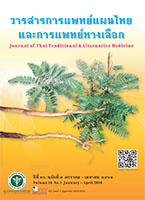Volume Calibration of “Tha-nan”and the effects in the efficacy of drugs preparation
Main Article Content
Abstract
“Tha-nan” in Thai traditional scriptures was different from “tha-nan luang”, the latter being a unit of volume equivalent to 1 liter. “Tha-nan luang” was used to measure out crude drugs for preparing medicines instead of traditional “tha-nan”, which might affect prepared drugs’ efficacy. The objective of this study was to calibrate the volume of traditional tha-nan and to evaluate the efficacy of wound-healing remedies prepared using calibrated tha-nan, compared with those prepared using tha-nan luang, in healing excision wounds on male Spraque-Dawley rats. The calibrated volume of “tha-nan” was calculated by multiplying the traditional “tha-nan” size number with 1.548, the converting factor, to obtain the volume in milliliters. The efficacy evaluation of the prepared wound-healing remedies showed that the oil remedies prepared with crude drugs measured out using the calibrated tha-nan (NR119/78cv) of 929 milliliters based on “tha-nan 600” and the balm remedy prepared with crude drugs measured out using the calibrated tha-nan (WP255/2cv) of 1,285 milliliters based on “tha-nan 830” were more efficacious than those prepared with crude drugs measured out using tha-nan luang.
Article Details
References
2. Picheansoonthon C, Tiyaworanant S, Jirawongse V. The handbook of Thai traditional pharmacy, vol. 6: Pharmacy. Bangkok: Amarin; 2013. 422 p. (in Thai)
3. De La Loubère S. La Loubère’s archives of Siam. Sunt T. Komolboottra (Trans.). 3rd ed. Bangkok: Sripunya; 2009. 688 p. (in Thai)
4. Beechey D. Cypraea moneta Linnaeus. [Internet]. 1758 [cited 2016 Dec 11]. Available from: https://seashellsofnsw.org.au/Cypraeidae/Pages/cypraea_moneta.htm
5. Renaud ML. Observation on the behavior and shell types of Cypraea moneta (Mollusca, Gastropoda) at Enewetak, Marshall Islands. Pacific Science. 1976;30(2):147-58.
6. Division for the Protection of Thai Traditional and Indigenous Medical Knowledge. King Narai’s scripture of medical element, palm-leaf edition (Khamphi Thart Phra Narai , or Textbook of Phra Narai’s medicine). [Internet] 2012 [cited 2017 Aug 20]. Available from: https://ptmk.dtam.moph.go.th/book/คัมภีร์ธาตุพระนารายณ์ฉบับใบลาน.pdf (in Thai)
7. Traditional Medical School. Textbook of medicine on marble inscriptions of Wat Phra Chetuphon Vimolmangklararm (Wat Pho). Bangkok. [n.p.: n.p.; n.d.]. (in Thai)
8. Shigeyama M, Ohgaya T, Takeuchi H, Hino T, Kawashima Y. Formulation design of ointment base suitable for healing of lesions in treatment of bedsores. Chemical & Pharmaceutical Bulletin. 2001; 49(2):129-33.


